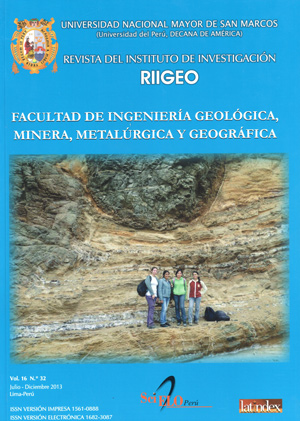Evidencias de paleosismicidad en la Región de Lima (Costa del Perú Central)
DOI:
https://doi.org/10.15381/iigeo.v16i32.11324Palabras clave:
Neotectónica, Sismita, Paleosismo, CuaternarioResumen
Los datos sobre los desastres naturales en esta parte de la margen andina solo son conocidos desde los primeros registros de las crónicas descritas por los españoles desde la etapa de la conquista, datos que han servido para las catalogaciones de los principales sismos y de relaciones ENSO. El estudio de la paleosismicidad requiere como base aplicar conceptos de la geología clásica a la última fase de deformación, los rasgos morfotectónicos o las deformaciones generadas por movimientos sísmicos fuertes o por deformación tectónica gradual ocurrida en este caso particular durante el Plio-Cuaternario. Para el área de Lima se tiene la identificación y caracterización de las estructuras sedimentarias generadas por el efecto sísmico sismitas; son estos depósitos inconsolidados que corresponden a depósitos fluviotorrenciales, lacustres, entre otros, los que presentan una relativa abundancia de figuras ligadas a eventos sísmicos, siendo las estructuras más comunes capas contorneadas (laminaciones onduladas) o invaginaciones, figuras de carga e inyecciones de material de arenas y/o arcillas. Con los datos obtenidos se hace un esbozo de la cronología relativa para estos eventos ocurridos en el valle fluvio aluvial del río Rímac.
Descargas
Publicado
Número
Sección
Licencia
LOS AUTORES RETIENEN SUS DERECHOS:
a. Los autores retienen sus derechos de marca y patente, y tambien sobre cualquier proceso o procedimiento descrito en el artículo.
b. Los autores retienen el derecho de compartir, copiar, distribuir, ejecutar y comunicar públicamente el articulo publicado en la Rev. Inst. investig. Fac. minas metal cienc. geogr. (por ejemplo, colocarlo en un repositorio institucional o publicarlo en un libro), con un reconocimiento de su publicación inicial en la Rev. Inst. investig. Fac. minas metal cienc. geogr.
c. Los autores retienen el derecho a hacer una posterior publicación de su trabajo, de utilizar el artículo o cualquier parte de aquel (por ejemplo: una compilación de sus trabajos, notas para conferencias, tesis, o para un libro), siempre que indiquen la fuente de publicación (autores del trabajo, revista, volumen, numero y fecha).






